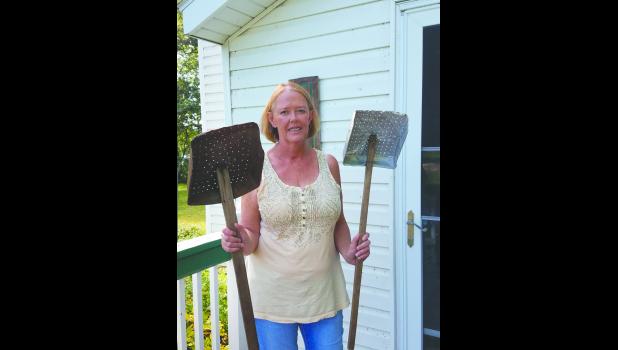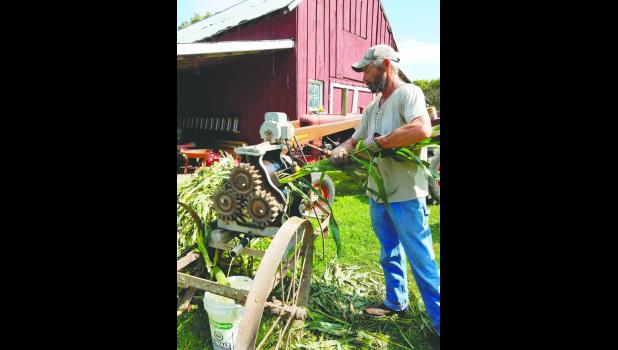It all boils down to a sweet life
BY BONNIE KAY BALDWIN
LAKE MILLS GRAPHIC
“It all started 35 years ago when Bonnie and I first got married. They had a maple syrup making demonstration at Helmer-Myre State Park (that they went to see). I thought, ‘I could do this.’ I remember my Grandma doing this,” said Pat Maher, Silver Lake, rural Northwood.
In 1991 the Mahers found out the property across from Pat’s dad’s land, was up for sale. When they saw what the farm had to offer, they snapped it up.
Pat and his wife, Bonnie, are considered alternative farmers—alternative crops/diversification of farming. They began with making maple syrup and raising honey bees. When they took their product to sell at different events, Pat noticed that most of the syrup and honey stands also had sorghum syrup for sale.
“So I got to thinking about sorghum,” said Pat. “There used to be a lot of it around here. During the second World War, when sugar was being rationed, making sorghum was one method people could use of making their own sweetener.”
Sorghum syrup is gluten free, and although it does not contain any dietary fiber, unlike sugar, it does have some nutritional value. In fact, during the time before mulivitamins were invented, it is said that doctors used to suggest that patients add sorghum to their diet. A quarter of a cup of sorghum syrup has 239 calories (equal to about 5 Tbsp. sugar), but is good for bones and teeth and has calcium, protein, iron, magnesium, phosphorus, potassium, zinc, and riboflavin.
“There were quite a few old sorghum presses around. Someone told me that Art Vermedahl had one,” said Pat. “So I went over and talked to Art. He was my mentor. He showed me how to grow it and got his press over here, and said I could borrow it if I want. That was 20 years ago. And it’s still the family’s press. And basically that’s how we got into it.”
“From what I know, there are four different kinds of sorghum. I grow what is called, Rox sorghum,” Pat said. “It will grow between eight and 12 feet tall. Depending on the variety, it looks just like corn except for the seed pods on top. Sorghum plants can become top heavy because of the seed pods.” Pat explained that he has one quarter of an acre of sorghum and the only thing he uses to harvest it is a corn knife.
First he strips the stalks of its leaves (wearing gloves) and then he makes a diagonal cut just above the ground and chops off the top of the stalk, just below the seed pods with another diagonal cut. (The seed pods can be harvested for grain as well.) If you don’t de-leaf it, he says, the leaves can clog up the press.
When asked how he knows when it’s ready to harvest, he said, that the seed pods change from a light color to a red and/or brownish-orange color and there will be red streaks in the cane as well.
“Our press has been modified, and runs off an electric motor.” The seasoned farmer showed how to feed the cane into the press, and and how the juice then flows out the side, into a pail covered with cheesecloth. The remnants of the cane feed out the back onto the ground, next to the press.
Next, he starts up a large fire in a handmade stone fireplace, where a stainless steel pan he had custom-made, (eight feet by two feet, by approximately eight-inches deep) can be moved onto the fire. He then pours five-gallon pails of light green opaque juice into the tray and lets it come to a boil. After it cooks for a while, foam starts to form on the top of the liquid. In order to skim the foam off, Bonnie and Pat, use a couple skimmers made from two old cake pans with holes in them attached to wood handles that are glided across the surface time and time again. Once it starts cooking, it has to be tended to until it’s done . . . a matter of hours. During this process no more juice can be added.
“My dad always told me, as a farmer, you can’t count your time.”
The custom-made pan holds 45 gallons of juice, which makes about a gallon of sorghum syrup.
When the juice reduces to a certain amount, Pat will pour some into a cast iron pan over a smaller fire, where he can control it better. When it reaches a certain temperature (which Pat can eyeball now), then it is ready to be put in jars, labeled under ‘Silver Lake Syrup Company.’
The Mahers sell their products at places like Kiester’s Farming of Yesteryear, Forest City’s Heritage Park and Junkapalooza, Northwoods Founder’s Day and Osage’s Autumn Artistry.
Their product line includes: maple and sorghum syrup; honey; jams and jellies made from their wild berries like mulberry, elderberry, and choke cherry; pumpkins and apples.
Pat summed it all up by saying, “I like going out in the woods to get the berries. I like tapping the trees. I really like messing with the bees, and making syrup. I enjoy it all.”



